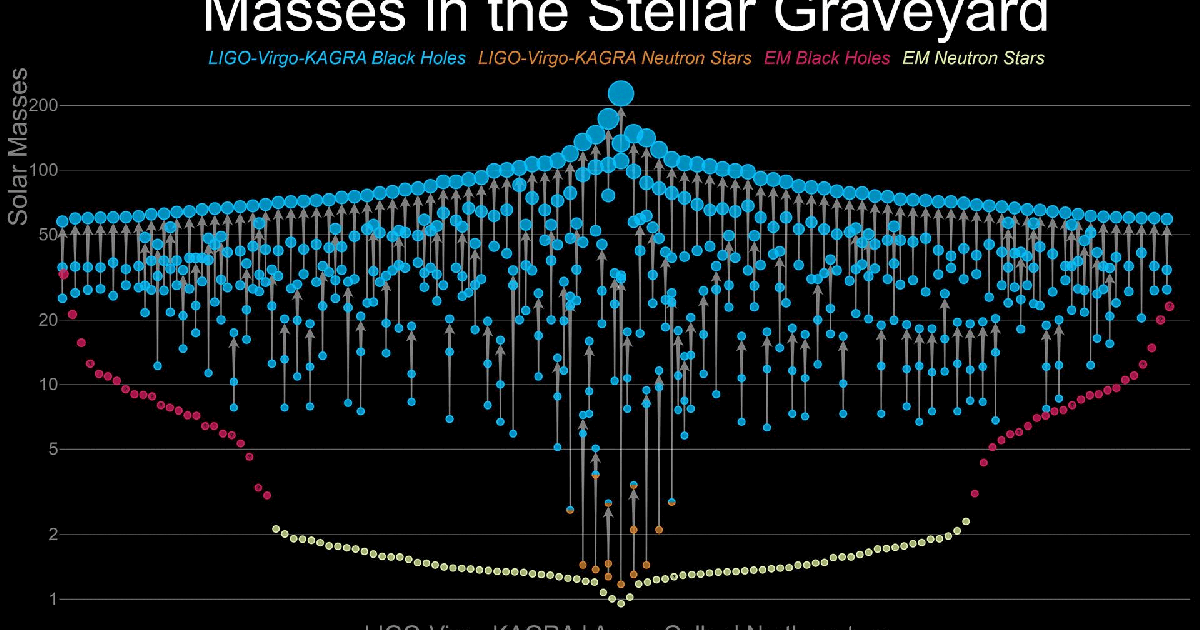Sign up for the Starts With a Bang newsletter
Travel the universe with Dr. Ethan Siegel as he answers the biggest questions of all.
It’s amazing how far we’ve come, scientifically, in the span of only ten years. Back in 2015, humanity didn’t know whether a core prediction of Einstein’s General Relativity — the existence of energy-carrying gravitational waves — was true or not. We had theoretical predictions that these waves should be generated whenever a massive object moved and accelerated through a changing gravitational field, and we had observed orbital decay of binary systems (like binary pulsars) that were consistent with those predictions, but the ripples in spacetime themselves, or gravitational waves, had never been directly detected. For 100 years, this great prediction of physics remained unconfirmed.
Then, on September 14, 2015, all of that changed. The twin LIGO (Laser Interferometer Gravitational-wave Observatory) detectors both saw small, periodic changes in the length of their four-kilometer-long laser arms, which heralded the arrival of gravitational waves from two black holes that had recently inspiraled and merged from across the Universe. With that one event, the era of gravitational wave astronomy was born: a wholly new type of astronomy that didn’t use telescopes, but rather was sensitive to the ripples in spacetime generated by these energetic mergers of compact objects.
Now in 2025, after years of observing runs punctuated by a steady series upgrades between them, LIGO — in the midst of its fourth observing run — has just more than tripled the number of known black hole mergers, going from around 90 at the end of the third run to around 300 today. Here’s how far we’ve come in the last decade, and how, if we don’t take radical action, this era might come to a sudden, unceremonious end.
An animated look at how spacetime responds as a mass moves through it helps showcase exactly how, qualitatively, it isn’t merely a sheet of fabric. Instead, all of 3D space itself gets curved by the presence and properties of the matter and energy within the Universe. Space doesn’t “change shape” instantaneously, everywhere, but is rather limited by the speed at which gravity can propagate through it: at the speed of light. The theory of general relativity is relativistically invariant, as are quantum field theories, which means that even though different observers don’t agree on what they measure, all of their measurements are consistent when transformed correctly.
The story of gravitational waves begins with Einstein’s General Relativity. If all you have is one static, unchanging mass in your spacetime, it’s going to be stable and unchanging: the mass will remain constant and so will the spacetime surrounding it. But if you have a second mass in the vicinity of the first, they’ll both accelerate due to the influence of the other, moving around through spacetime, all while the spacetime’s curvature itself changes in response. This has a profound effect in analogy with electromagnetism.
- In classical electromagnetism (obeying Maxwell’s equations), an electrically charged particle moving or accelerating through a changing electromagnetic field will emit electromagnetic radiation in the form of light, or photons.
- Similarly, in classical gravity (obeying Einstein’s equations), a massive particle (with a gravitational charge) moving or accelerating through a changing gravitational field (a region of spacetime where the curvature changes) will emit gravitational radiation in the form of gravitational waves.
These waves must carry energy and must move at the speed of light. And, according to the theory of General Relativity, as those gravitational waves propagate away from the massive sources that generated them by their motion through spacetime, they cause the space that they propagate through to alternately expand (grow) and contract (shrink), in phase, in mutually perpendicular directions.
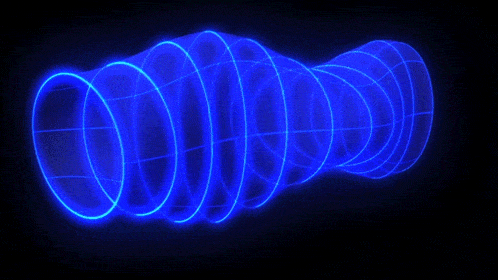
When a gravitational wave passes through a location in space, it causes an expansion and a compression at alternate times in alternate directions, causing laser arm-lengths to change in mutually perpendicular orientations. Exploiting this physical change is how we developed successful gravitational wave detectors such as LIGO and Virgo. However, unlike this illustration, the gravitational waves do not simply propagate in a “tube,” but rather spread out through all of three-dimensional space.
For a long time, astronomers hoped to uncover evidence for the existence of these gravitational waves. They got a whiff of hope back in 1974, when astronomers Russell Hulse and Joseph Taylor discovered a highly unusual star system: a system containing two neutron stars, where one of those neutron stars was emitting regular pulses every 59 milliseconds. Known as a binary pulsar, the arrival time of the pulses exhibited regular variations every 7 hours and 45 minutes, which led to the detection of the binary companion. Each neutron star is massive — containing more mass than the entire Sun — but extremely compact, at around ~20 kilometers in size. They orbit one another in a very elliptical fashion, coming as close as 746,600 kilometers (about the radius of the Sun) but reaching maximum separations of 3,153,600 km (about four solar radii).
Here’s the kicker, though: these orbits aren’t constant over time, but very slowly decay. As these large masses move through space at close separations to one another, the accelerated motion through spacetime whose curvature is changing results in the steady emission of gravitational waves, where that emitted energy comes at the expense of the orbital energy of the two bodies. Each year, the orbits shrink by about 3.5 meters, and the orbital period shortens by 76.5 microseconds. Although the gravitational waves from these two neutron stars are too weak to directly detect, the observed change in the pulse periods over time provided indirect evidence that these gravitational waves must exist.
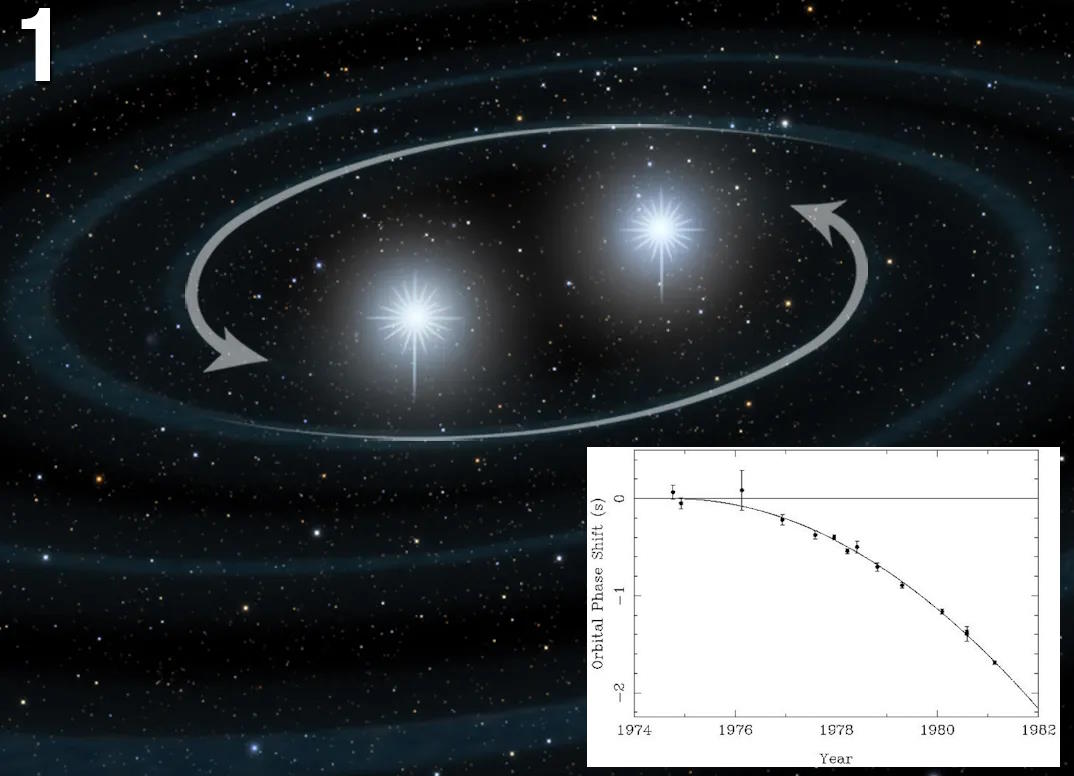
As two neutron stars orbit one another, the motion of one mass through the curved spacetime generated by the other mass results in the emission of gravitational waves, which carry energy away and cause the orbits to decay. The first binary neutron star system, where at least one neutron star is a pulsar, was discovered in 1974. Even as early as 1982, as the inset diagram shows, the orbit could be observed decaying, in agreement with General Relativity’s predictions.
However, there ought to be sources that were so energetic out there in the Universe that, in principle, an appropriately designed gravitational wave detection apparatus could be sensitive to those ripples in spacetime. In particular, when a compact, massive source and another compact, massive source achieve very tight orbits with one another, they’ll reach such small separations that either:
- their surfaces will touch and they’ll interact,
- or, if one or both of the objects is a black hole, one object will encounter the event horizon of the other and merge.
These are the scenarios that emit gravitational waves of the maximum amount of energy, with the frequency of the emitted gravitational waves corresponding to the masses of the objects and their minimum separation distances before interaction and/or merger.
In order to detect these gravitational waves, you have to understand that the waves will propagate through space, causing expansion-and-contraction oscillations to happen when the waves pass through. To catch them passing through, scientists concocted the brilliant design of gravitational wave detectors: sending a split laser pulse down two mutually perpendicular vacuum tubes, reflecting them back-and-forth many times, and then bringing them back together to construct an interference pattern. When there’s no gravitational wave, the pattern remains constant, but when a gravitational wave passes through the apparatus, the path lengths change, altering the arrival time of the pulses and leading to detectable changes in the interference pattern that results.
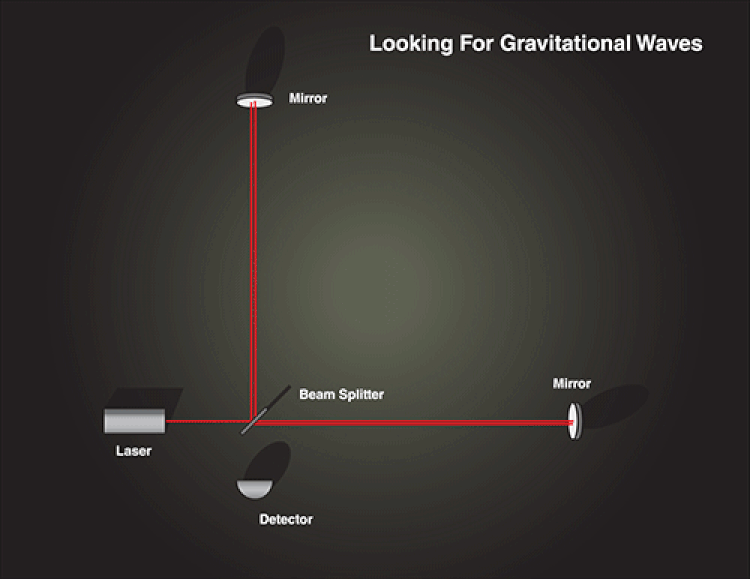
When the two arms of an optical interferometer are of exactly equal length and there is no gravitational wave passing through, the signal is null and the interference pattern is constant. As the arm lengths change, the signal is real and oscillatory, and the interference pattern changes with time in a predictable fashion. This technique is what is used to directly reveal the presence of gravitational waves.
That’s the basics of how gravitational wave detectors works. LIGO — with twin detectors located in Livingston, Louisiana and Hanford, Washington — used arms that were approximately 4 kilometers each in length and leveraged about 1000 laser reflections in each one before those two laser beams were brought back together. Theorists calculated thousands of gravitational wave templates based on the types of:
- black hole-black hole mergers,
- black hole-neutron star mergers,
- and neutron star-neutron star mergers
that they expected to occur across the Universe, modeling a variety of spins, masses, and orientations to them.
Advanced LIGO, which grew out of the proof-of-concept prototype that was the original LIGO, turned on in early September of 2015. While still undergoing calibration, this first gravitational wave unexpectedly arrived, but the detectors were performing so well, and the arriving signal was so strong, that both detectors immediately registered the signal. Humanity had detected our first ever gravitational wave event: a merger of two black holes, one of 36 solar masses and another of 29 solar masses, that resulted in the production of a 62 solar mass black hole. With just a little math, you’ll notice that 3 solar masses were “lost,” but they weren’t actually lost; they were merely converted to energy via E = mc², where that energy was in the form of gravitational waves.

GW150914 was the first ever direct detection and proof of the existence of gravitational waves. The waveform, detected by both LIGO observatories, Hanford and Livingston, matched the predictions of general relativity for a gravitational wave emanating from the inward spiral and merger of a pair of black holes of around 36 and 29 solar masses and the subsequent “ringdown” of the single resulting black hole.
By transferring a tiny amount of that gravitational wave energy into the LIGO detectors, we were able to detect that signal from across the Universe. Subsequently, more data was taken, and a few more events were seen. After detecting those events, both detectors were shut down and received upgrades, with some of the systems that received upgrades being:
- the vacuum systems within the laser cavities,
- the temperatures and reflectivities of the mirrors,
- the squeezing of the quantum states that created the laser beams,
- and the sources of error and noise that limited the detector’s sensitivity were lowered as well,
making LIGO more sensitive to gravitational waves generated at greater distances. With each new factor of two in sensitivity that LIGO (or any gravitational wave detector) achieved, it became sensitive to eight times as much volume as previously, since our three-dimensional space means that twice the sensitivity enables detections at double the distance in all three dimensions. Every new upgrade meant increased sensitivity, which meant a greater volume of the Universe to probe for these gravitational wave events. More volume means more events, and that means the rate of detections only increased as these upgrades continued.
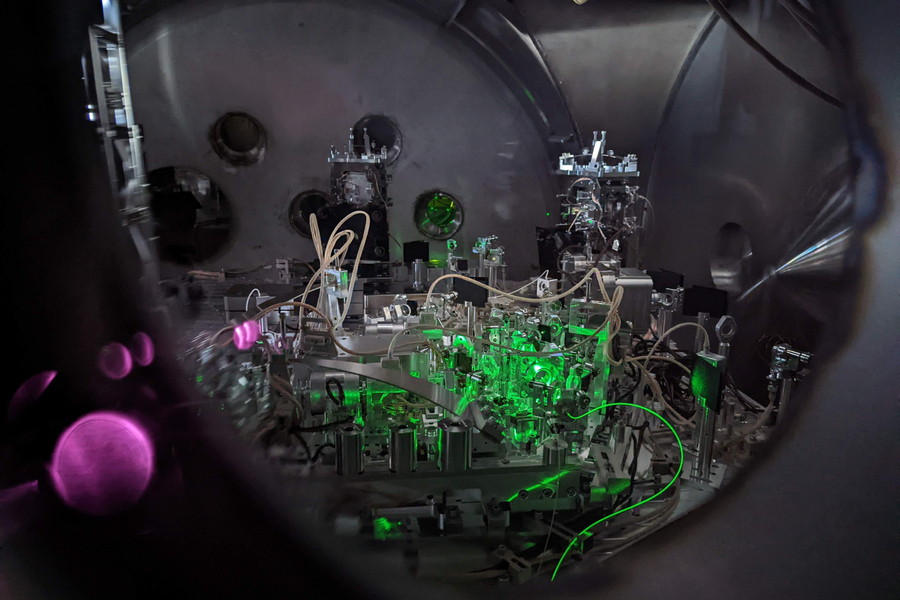
Within LIGO’s vacuum chamber, laser light is now created in not only a squeezed fashion, but where quantum squeezing occurs in a frequency-dependent fashion. The squeezer is operational in this photo, as green laser light is being pumped through it.
LIGO was then joined by the Virgo detector, a slightly smaller gravitational wave detector in Europe, which enabled astronomers to pinpoint (or triangulate, because we now had three detectors total) the location from which gravitational wave events emerged. By the end of the second observing run, we had reached double digits of gravitational wave detections, with the first neutron star-neutron star merger joining all of the other black hole-black hole merger we’d seen. When the second observing run came to a close, further upgrades to LIGO and Virgo were enacted, and then later on, the KAGRA detector joined the gravitational wave party as well.
By the end of the third observing run in 2020, a total of around 90 gravitational wave events had been seen. By this point, all three types of events, including neutron star-neutron star mergers and neutron star-black hole mergers, were all seen. We learned that neutron star-neutron star mergers didn’t always produce kilonovae, but sometimes, dependent on properties such as the initial masses of the neutron stars, would lead to a black hole directly upon contact. Some of the black hole mergers seen fell into the “mass gap” window of between 5 and 10 solar masses: a region where some had theorized black holes couldn’t have existed. In only a few years, we knew of more stellar mass black holes from gravitational wave events than from all other methods of detection combined.
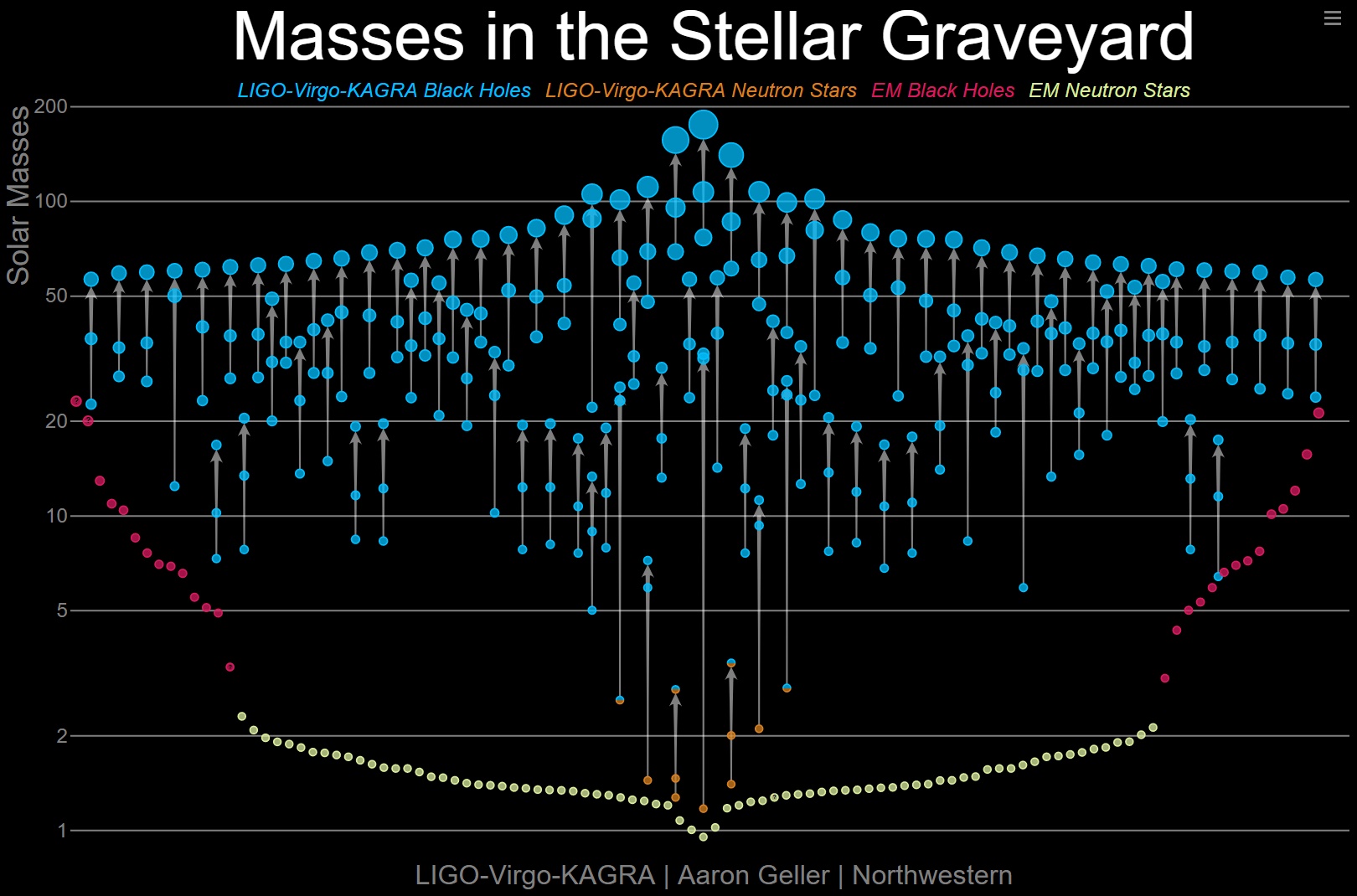
The most up-to-date plot including LIGO’s Observing Run 3 data, as of November 2021, of all the black holes and neutron stars observed both electromagnetically and through gravitational waves. While these include objects ranging from a little over 1 solar mass, for the lightest neutron stars, up to objects a little over 100 solar masses, for post-merger black holes, gravitational wave astronomy is presently only sensitive to a very narrow set of objects. The closest black holes had all been found as X-ray binaries, until the November 2022 discovery of Gaia BH1. The mass “border” between neutron stars and black holes is still being determined.
In fact, black hole-black hole mergers were by far the most ubiquitous type of event that appeared in gravitational waves, and the twin LIGO detectors remained the strongest sources of signal for all such observed events. In a new pair of papers whose preprints were released on August 25, 2025 — just three weeks prior to the 10-year anniversary of the arrival of the first directly detected gravitational wave — the LIGO, Virgo, and KAGRA collaborations combined to release a new catalogue of their highest-significance detection events of all-time. Although the ongoing Observing Run 4 has detected more than 200 sources on its own, the new catalogue stops with the events ending in January of 2024, bringing the total up to 218 released and vetted events, more than doubling the total (of 90) from the end of Observing Run 3.
The graphs you see (sometimes called “Eagle plots” because of their shape), above and below, shows the known black holes and neutron stars below 300 solar masses. The top graph shows the ones known at the end of Observing Run 3 alone; the lower graph shows the ones as of the end of the first part of Observing Run 4. The blue points indicate black holes detected from gravitational waves, the orange points indicate neutron stars observed in gravitational waves. The red and yellow points, for comparison, show black holes and neutron stars detected through electromagnetic (light-driven) signals, showcasing just how remarkable the science of gravitational wave detection has been for learning about the populations of black holes below ~300 solar masses.
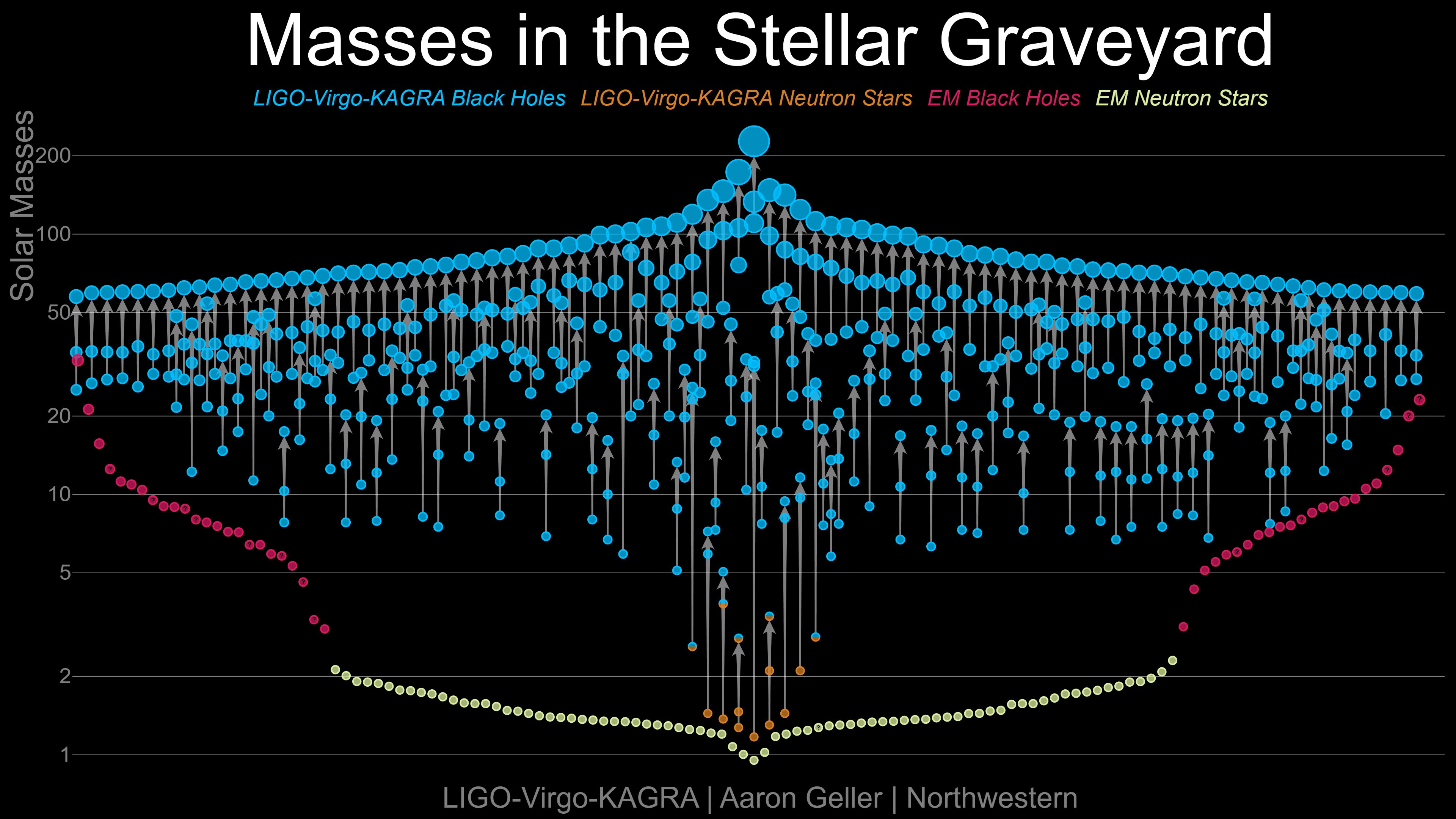
This “Eagle” plot shows the black holes and neutron stars, as a function of mass, that were detected by either gravitational wave events (blue and orange) or with electromagnetic signatures (red and yellow). With the advent of the first part of LIGO’s Observing Run 4 data, we now have 218 robust gravitational wave events, with approximately 100 more in the pipeline.
As you can see even from just a visual inspection, there is no “mass gap” where objects are completely absent. However, visual inspections are insufficient tools for determining if there’s a population deficit or excess at any given mass or across any particular mass range; if we want to determine what’s present, what’s anomalous, and what appears to be missing, we have to perform the appropriate quantitative analysis. Fortunately, that’s what the second of the two released preprints, both of which are to be published in a special issue of Astrophysical Journal Letters, is all about.
Indeed, there isn’t a mass “gap” between around 5 and 10 solar masses, but there is a substantial mass deficit; there are more objects at lower masses and at 10 solar masses and above than there are masses in the in-between range. There’s are two, maybe three spikes in the mass distribution of black holes, with a peak at 10 solar masses and another peak at 35 solar masses, with a possible (but less significant) third feature at around 20 solar masses. Above 35 solar masses, the abundance of black holes drops off somewhat more steeply than the simple power-law curve that describes black holes at lower masses, suggesting some suppression of those higher-mass black holes. (Although the ones that do exist produce the largest-amplitude gravitational wave signals, making them relatively easy to spot.)
Below, a graph from the paper highlights some of these features.
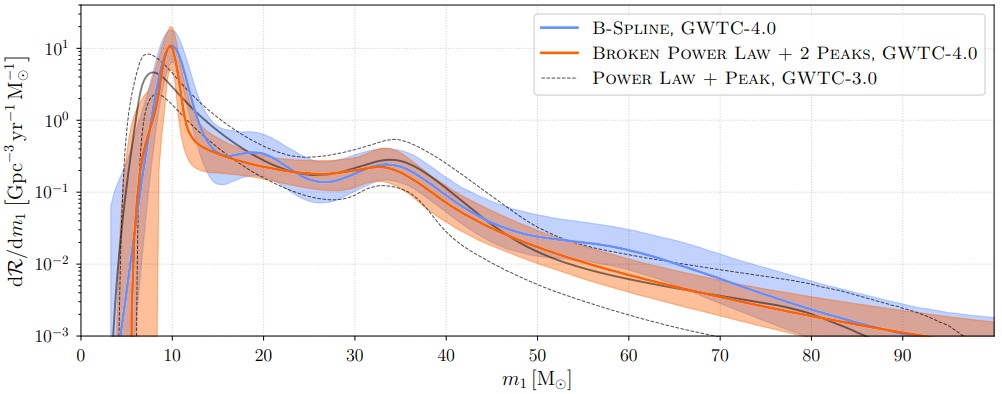
This graph shows the differential merger rate (y-axis) as a function of the mass of the heavier black hole (x-axis) involved in the merger of two black holes as seen in gravitational wave events. The orange and blue shaded areas indicate the confidence intervals of two different models, both of which show peaks at 10 and 35 solar masses, and one of which shows an additional peak at around 20 solar masses.
Some features, upon a deep analysis, stuck out. When you have a pair of binary black holes, they’re not just going to orbit one another and inspiral, but each black hole can have a spin to it, and those spins, cumulatively, can be either aligned or anti-aligned with the orbital angular momentum of the binary system. When the collaboration members looked at the spins of systems with at least one black hole in the 30-to-40 solar mass range — right where the heaviest “peak” in the mass of black holes is found — they found that spins were only a little more likely to be aligned compared to anti-aligned (about a 65/35 split).
However, for systems that didn’t have a black hole in that mass range (i.e., for all other binary black hole mergers), they found that spins were far more likely to be aligned compared to anti-aligned, showing an impressive 87/13 split. If you model the formation of stars that evolve into black holes, you expect that the spins of the stars (and the spins of the resultant black holes) should be preferentially aligned with their binary orbits, but if you model black holes that merge together as part of trinary (or richer) systems, you expect that the post-merger spin will be much more random with respect to any remaining members. This was suggested in a paper back in 2016, and appears to be consistent with the latest data. Perhaps the “peak” at 35 solar masses is due to mergers of previous black holes that produced at least one member of between 30 and 40 solar masses? It’s an intriguing idea, and one that’s suggested (but not proven) by the current data.

At left, an isolated system, formed from two original members of a binary star system, tends to produce black holes aligned with the orbital motion of the original progenitor stars, leading to black hole mergers with aligned spins. However, for dynamically captured black holes, or for black holes arising from trinary (or richer) systems, those rules and tidal effects don’t apply as strongly, producing a closer to 50-50 split of aligned versus anti-aligned spins.
Thus far, here in 2025, LIGO and the other gravitational wave observatories around the world have continued to take data, discovering approximately 100 additional gravitational wave events (mostly black hole-black hole mergers) that aren’t included in the papers that were just released. In less than 10 short years, we’ve gone from, “we think gravitational waves exist, but we’ve never seen one” to being able to:
- measure hundreds of gravitational wave events,
- pinpoint where on the sky they occur,
- infer the population of stellar mass black holes in the Universe,
- including where there are gaps and peaks in the mass distribution,
- and even to uncover information about the correlations between the black hole spins and the merger orbits.
What was once just a pipe dream of astronomers, physicists, and General Relativists has swiftly grown into a robust field of observational astronomy.
At the start of 2025, astronomers had dreams of two successor facilities:
- LIGO II, which would be a ground-based detector (or multiple detectors) with much longer-baseline arms, of 10 km or more, capable of seeing practically every stellar mass black hole-black hole merger within the observable Universe.
- And LISA, the Laser Interferometer Space Antenna, which would allow the detection of more massive black hole mergers, including intermediate mass and some supermassive black hole mergers, for the first time.

This photograph, taken at LIGO Livingston in Louisiana, shows a perspective of looking “down” one of the two perpendicular 4 kilometer arms through which laser light is reflected many times and brought together to construct an interference pattern that’s sensitive to the presence of gravitational waves. With a detector that has arms ten times as long, we’d be sensitive to such events at much greater distances, as well as to orbiting objects with periods that take up to 10 times longer, allowing us to fill in the gap between what LIGO and LISA are sensitive to. The NSF’s “LIGO II” would allow us to close that gap: either partially or wholly.
Instead of those dreams that look forward to continued advances at the frontier of science, however, gravitational wave astronomers are instead facing the extinction of their own field right as it’s poised to take off. The catastrophic proposed FY2026 budget contains a $9 billion cut to the National Science Foundation, with specific instructions to close down one of the two main LIGO facilities. As one astrophysicist put it, degrading LIGO’s observations of gravitational waves in this fashion is tantamount to “killing a newborn baby,” or as another quipped, it’s a “senseless, irrational thing to do… like trying to fly a plane with only one wing.”
When you couple the proposed National Science Foundation cuts with NASA’s redirection of priorities away from science and instead towards militarized projects like nuclear activity on the Moon, it becomes apparent that the status of the United States as a world leader in physics and astrophysics is more precarious than ever, with even the upcoming Habitable Worlds Observatory under threat. If we abandon this new form of science now, while it’s still in its infancy, progress will likely be set back by decades, if not an entire generation or more. And that’s a pity, because the awe and wonder that this era of gravitational wave astronomy has brought to us is truly unprecedented.
Still, despite the external pressures and threats of withheld funding, there is no diminishing the achievements of gravitational wave astronomy in the last decade. One cannot help but be simultaneously humbled and inspired by how far we’ve come both scientifically and technologically in the realm of gravitational wave detection. After all we’ve learned so much in such a short time, and we’ve done it with a new form of astronomy that, for 100 years, was no more than an unproved prediction of our theory of gravity.
The Universe is full of black holes, and for the first time, we have direct, data-driven estimates of just how many there are and of their mass distribution. All of this was only made possible by the new science of gravitational wave astronomy, which is thriving at a greater level than ever before. Even as the very field itself is at risk of a premature termination, the legacy of what we’ve already accomplished, and the hope it gives us all for the future of science, can never be erased.
Sign up for the Starts With a Bang newsletter
Travel the universe with Dr. Ethan Siegel as he answers the biggest questions of all.
